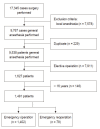Risk factors of emergency reoperations
- PMID: 33329819
- PMCID: PMC7713825
- DOI: 10.17085/apm.2020.15.2.233
Risk factors of emergency reoperations
Abstract
Background: Emergency reoperation is considered to be a quality indicator in surgery. We analyzed the risk factors for emergency reoperations.
Methods: Patients who underwent emergency operations from January 1, 2017, to December 31, 2017, at our hospital were reviewed in this retrospective study. Multivariate logistic regression was performed for the perioperative risk factors for emergency reoperation.
Results: A total of 1,481 patients underwent emergency operations during the study period. Among them, 79 patients received emergency reoperations. The variables related to emergency reoperation included surgeries involving intracranial and intraoral lesions, highest mean arterial pressure ≥ 110 mmHg, highest heart rate ≥ 100 beats/min, anemia, duration of operation >120 min, and arrival from the intensive care unit (ICU).
Conclusions: The type of surgery, hemodynamics, hemoglobin values, the duration of surgery, and arrival from ICU were associated with emergency reoperations.
Keywords: Anesthesia; Emergency operation; Emergency reoperation; Risk factors.
Copyright © the Korean Society of Anesthesiologists, 2020.
Conflict of interest statement
CONFLICTS OF INTEREST No potential conflict of interest relevant to this article was reported.
Figures
Similar articles
-
Reoperations within 48 hours following 7942 pediatric neurosurgery procedures.J Neurosurg Pediatr. 2017 Jun;19(6):634-640. doi: 10.3171/2016.11.PEDS16411. Epub 2017 Mar 31. J Neurosurg Pediatr. 2017. PMID: 28362185
-
Unplanned reoperation rates in pediatric neurosurgery: a single center experience and proposed use as a quality indicator.J Neurosurg Pediatr. 2012 Jun;9(6):665-9. doi: 10.3171/2012.2.PEDS11305. J Neurosurg Pediatr. 2012. PMID: 22656260
-
The Incidence and Causes of Unplanned Reoperations as a Quality Indicator in Pediatric Surgery.Children (Basel). 2022 Jan 13;9(1):106. doi: 10.3390/children9010106. Children (Basel). 2022. PMID: 35053730 Free PMC article.
-
Systematic Review and Meta-Analysis of Unplanned Reoperations, Emergency Department Visits and Hospital Readmission After Thyroidectomy.Thyroid. 2018 May;28(5):624-638. doi: 10.1089/thy.2017.0543. Thyroid. 2018. PMID: 29587583
-
Reoperations Following Lumbar Spinal Canal Stenosis.Indian J Orthop. 2018 Nov-Dec;52(6):578-583. doi: 10.4103/ortho.IJOrtho_380_17. Indian J Orthop. 2018. PMID: 30532296 Free PMC article. Review.
Cited by
-
Predictors of hospitalization for longer than one day following elective single-level anterior cervical discectomy and fusion: a retrospective case-control database study.Asian Spine J. 2025 Jun;19(3):389-398. doi: 10.31616/asj.2024.0321. Epub 2025 Mar 4. Asian Spine J. 2025. PMID: 40033722 Free PMC article.
-
Evaluating the risk of return to the operating room across all elective orthopaedic procedures.J Orthop Surg Res. 2024 Jun 2;19(1):328. doi: 10.1186/s13018-024-04814-9. J Orthop Surg Res. 2024. PMID: 38825677 Free PMC article.
References
LinkOut - more resources
Full Text Sources


